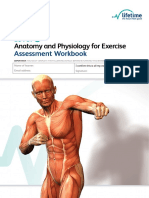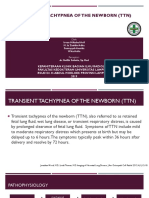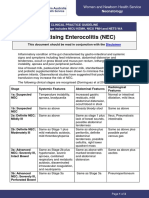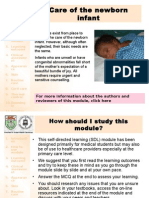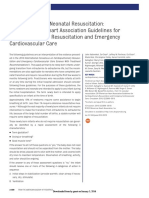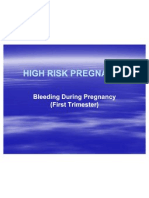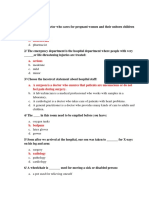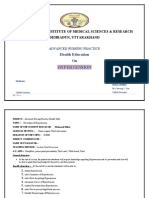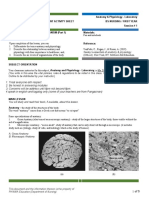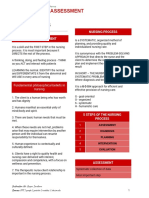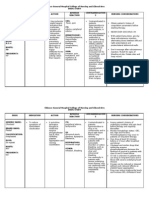Case 7 - Newborn With Respiratory Distress
Case 7 - Newborn With Respiratory Distress
Uploaded by
Sue HuangCopyright:
Available Formats
Case 7 - Newborn With Respiratory Distress
Case 7 - Newborn With Respiratory Distress
Uploaded by
Sue HuangOriginal Title
Copyright
Available Formats
Share this document
Did you find this document useful?
Is this content inappropriate?
Copyright:
Available Formats
Case 7 - Newborn With Respiratory Distress
Case 7 - Newborn With Respiratory Distress
Uploaded by
Sue HuangCopyright:
Available Formats
Case 7: Newborn with Respiratory Distress Details of the delivery are always important in assessing a newborn.
In Proceed to the next card and rank the items in the differential this case, "fair" glucose control, unknown Group B strep status, diagnosis. prematurity, and C-section delivery all point to possible causes of respiratory distress. The most likely diagnosis for Adam is Transient Tachypnea of the Newborn or TTN. Transient tachypnea of the newborn is the result of Maternal diabetes is a risk factor for respiratory distress syndrome and delayed clearance of lung fluid following birth. other difficulties. Maternal group B strep infection is a risk factor for neonatal sepsis. Prematurity predisposes to respiratory distress Respiratory distress syndrome is the result of lung-surfactant syndrome (RDS) caused by lung immaturity and lack of surfactant, deficiency and is the most common cause of respiratory distress in but most infants born at 36 weeks' gestational age do not have RDS. premature infants. C-section delivery predisposes to transient tachypnea of the newborn. Congestive Heart Failure (CHF) in infants is most often caused by a Additional risk factors that were NOT present in this case include congenital heart defect. - Premature rupture of membranes 18 hours, a risk factor for neonatal sepsis Hypothermia should be considered in the differential diagnosis of a - Meconium in the amniotic fluid, a risk factor for meconium tachypneic newborn. aspiration syndrome. Pneumothorax is relatively uncommon, but is always an important consideration in an infant with respiratory distress. Ms. Mason is taking no medications and has no history of other drug use. While possible this is unlikely based on the history. Neonatal sepsis can present initially with tachypnea and progress to Infants who aspirate meconium in utero or at the time of delivery more severe illness rapidly. Prolonged rupture of the membranes, not often present with symptoms of respiratory distress, including present in this case, is associated with an increased incidence of tachypnea. There was no meconium in the amniotic fluid making this neonatal sepsis. Neonatal sepsis is often due to Group B Beta Strep, an unlikely diagnosis. usually transmitted from the mother during labor. We do not know whether the mother was a GBBS carrier. This is an important Asthma is not a diagnoses in the neonatal period, making this diagnosis to consider, especially in premature infants. diagnosis unlikely. Pulmonary embolism is very rare in children and usually is a result of a clotting disorder. Pulmonary embolism is only seen in neonates who have a predisposing condition such as the placement of a central venous catheter. Adam does not have this risk factor making this diagnosis unlikely.
Adam's birth weight is above the 90th percentile for his presumed 36week gestational age. If gestational age assessment confirms that he is indeed 36 weeks, he would be classified as large for gestational age (LGA). This is the term used to identify those newborns with birth weight above the 90th percentile. Although many LGA infants are constitutionally large, the most important pathologic etiology is maternal diabetes mellitus. You will need to defer the gestational age assessment until his clinical condition stabilizes, but you must be aware of potential clinical problems associated with being LGA: - Large infants often must be delivered by C-section, by forceps, or vacuum extraction (all of which have associated complications) - Birth injuries are more common, such as fractured clavicle, brachial plexus injury, and facial nerve palsy - Hypoglycemia is especially common in LGA infants born to diabetic mothers Newborns who are appropriate for gestational age (AGA) have birth weights between the 10th and 90th percentiles. An infant with low birth weight may be premature, but low birth weight may also result from many other causes. Newborns with birth weights below the 10th percentile for gestational age are classified as small for gestational age (SGA) or intrauterine growth restricted (IUGR). The terms SGA and IUGR are both used in the literature, although the newer literature tends to favor the term intrauterine growth restriction (IUGR). The SGA baby has unique potential problems, which may include: - Temperature instability (hypothermia) - Hypoglycemia because of inadequate glycogen stores - Polycythemia and hyperviscosity
The Apgar score describes the condition of the newborn infant immediately after birth and, when properly applied, is a tool for standardized assessment. It provides a mechanism to record fetal-toneonatal transition. The Apgar score alone correlates poorly with the future neurological outcome of the term infant. This is because the Apgar score is affected by gestational age, maternal medications, resuscitation, and cardiorespiratory and neurologic conditions that may be present in the infant. Low Apgar scores at 1 and 5 minutes alone are not conclusive markers of an acute intrapartum hypoxic event. Poor neurologic outcome is better associated with documented asphyxia, and that is why it is important to obtain arterial blood gases to look for metabolic acidosis. There is a need for health care professionals to be consistent in assigning an Apgar score during a resuscitation. A neonate's birth weight is a good indicator of the health of the intrauterine environment. Plotting the weight against gestational age helps to identify infants with abnormal growth and allows the anticipation of potential problems associated with each group.
Persistent pulmonary hypertension of the newborn
All of the tests listed above should be considered in the evaluation of a cyanotic newborn.
Persistent pulmonary hypertension of the newborn (PPHN) is the result of elevated pulmonary vascular resistance to the point that Arterial blood gases help in determining the oxygenation, ventilation, venous blood is diverted to various degrees through fetal channels (the and acid-base status of the infant. Knowing the pCO2 is very helpful in ductus arteriosus and foramen ovale) into the systemic circulation and understanding the cause of the cyanosis. bypasses the lungs, resulting in systemic arterial hypoxemia. The CBC with differential count is useful to rule out neutropenia, leukopenia, abnormal immature-to-total-neutrophil ratio, and Link to a diagram illustrating this blood flow. thrombocytopenia as signs of sepsis. PPHN can result from several conditions, including meconium A chest radiograph is an integral part of the initial assessment of the aspiration syndrome, diaphragmatic hernia, hypoplastic lungs, and in utero asphyxia. The following findings may indicate that an infant has newborn with respiratory distress. The size and the shape of the heart may yield some clues to the diagnosis. The appearance of the lungs PPHN: may suggest pneumonia, meconium aspiration, RDS, etc. Normal inspiratory films should have eight or more intercostal spaces of lung - Tachypnea fields on both sides. - Tachycardia - Respiratory distress, with findings such as expiratory grunting and An echocardiogram is the gold standard in the diagnosis of congenital nasal flaring cardiac lesions and persistent pulmonary hypertension of the newborn. - Generalized cyanosis An echocardiogram is indicated when there is persistent cyanosis and - Low oxygen levels, even while receiving 100% oxygen no indication of lung disease, or when there are other signs suggesting a heart defect, such as a murmur, an abnormal ECG or a chest X-ray showing an abnormal cardiac contour. An oxygen challenge test (hyperoxia test) is a valuable tool that can help differentiate between cardiac and pulmonary etiology in infants who are cyanotic. In brief, oxygen will increase the PaO2 of an infant whose cyanosis is caused by a respiratory condition, but will not significantly increase the PaO2 if a cardiac lesion causes cyanosis. This test is described in some detail in the article by Sasidharan. Physical examination is critical to identify heart murmurs and respiratory findings that might be the cause of the cyanosis. Remember, however, that some murmurs may not be present early in life because of the elevated pulmonary vascular pressure.
Pulse oximetry detects the oxygen saturation in the blood. The findings of tachypnea, retractions and grunting are classical symptoms of respiratory distress from any cause. Intercostal and subcostal retractions reflect the increased work of breathing due to decreased lung compliance, either due to primary lung pathology or edema. Grunting occurs at the end of expiration, and is the audible sound of air being expelled through a partially closed glottis as the infant attempts to increase transpulmonary pressures, increase lung volumes, and improve gas exchange. For Adams case, physical examination helps rule out some of these possibilities. Congenital diaphragmatic hernia is a congenital malformation resulting from a defect in the development of the diaphragm. It occurs in 1 out of every 2,200 to 5,000 live births. The most common type is the Bochdelek hernia (a posterolateral hernia) that accounts for the majority (> 95%) of cases. This defect allows the passage of organs from the abdomen into the chest cavity and severely impairs lung development. Most defects occur on the left side. Absent breath sounds or presence of bowel sounds on one side of the chest are important diagnostic clues. Adams physical examination with the presence of bilateral normal breath sounds makes this diagnosis unlikely.
Transposition of the Great Arteries (TGA) is a congenital heart defect in which the aorta and pulmonary arteries are transposed resulting in respiratory distress and severe cyanosis at shortly after birth as the patent ductus arteriosus closes. One risk factor for transposition of the great arteries is being born to a diabetic mother. TGA is often associated with other congenital heart defects such as a VSD so a murmur may be heard on physical examination. Adams normal cardiovascular examination and absence of cyanosis makes this diagnosis unlikely. Hypothermia can cause tachypnea and may be associated with neonatal sepsis. Small for gestational age and premature infants are at increased risk to develop hypothermia. Adams temperature is normal and he is an LGA infant making this diagnosis unlikely. Severe Coarctation of the Aorta may cause respiratory distress if there is severe left ventricular outflow tract obstruction. Classically, diminished pulses in the lower extremities or asymmetric blood pressure readings suggest the diagnosis. In severely ill neonates, there may be no differences in the pulses because cardiac output is so poor. Adams general appearance and normal pulses in all extremities argues against this diagnosis. Transient tachypnea of the newborn (TTN) - Because Adam is large for gestational age, was born by C-section, and his clinical picture does not fit the other diagnoses well, TTN is a likely diagnosis for his respiratory distress.
Pneumothorax is caused by a collection of gas in the pleural space with resultant collapse of lung tissue. Common risk factors are mechanical ventilation or underlying lung disease (especially meconium aspiration or severe infant respiratory distress syndrome). Infant Respiratory distress syndrome (RDS) remains a possibility, Absence of breath sounds on one side of the chest in combination with but is less likely than TTN in a 36-week gestation infant. A chest Xrespiratory distress is an important diagnostic clue. Adams physical Ray may help to distinguish between TTN and RDS examination with the presence of bilateral normal breath sounds makes this diagnosis unlikely.
Trimester HbA1C level: Infants born to women with HbA1C levels >12 have at least a 12-fold increase in major malformations. Hypoglycemia may be seen in infants of diabetic mothers due to the chronic hyperinsulinemic state that occurred during gestation. Hypoglycemia may be more pronounced in premature infants. Tachypnea is a non specific response to this metabolic derangement. This diagnosis remains a possibility for Adam and could be investigated by a serum glucose reading. Congestive heart failure is unlikely because Adam has a normal cardiovascular system with no murmur, normal pulses and normal oxygen saturation. This constellation of symptoms rules out most major cardiac causes of congestive heart failure. Neonatal sepsis is unlikely (but not impossible) because Adam has normal temperature, blood pressure and perfusion. In addition, his mother is well without fever suggesting she does not have chorioamnionitis. High levels of maternal serum glucose during pregnancy result in hyperglycemia in the fetus. This stimulates the fetal pancreatic beta cells and the development of hyperinsulinemia. Maternal insulin does not cross the placenta. Insulin is the primary anabolic hormone for fetal growth. High levels in the third trimester result in increased growth of the insulin-sensitive organ systems (heart, liver and muscle) and a general increase in fat synthesis and deposition. This combination of increased body fat, muscle mass, and organomegaly produces a macrosomic (LGA) infant. Insulin-insensitive organs, such as the brain and kidneys, are not affected by the elevated insulin levels, and have appropriate size for gestational age. Control of diabetes during pregnancy is an important predictor of fetal outcome, especially with regard to the risk of birth defects. The incidence of major malformations is directly related to the FirstWhen discussing medical problems that are evolving, it is important to be clear about what you know and what the next steps in the evaluation will be. It is difficult to balance the need to reassure parents and help them understand the potentially serious causes of their childs symptoms. Each of the above answer represents a reasonable approach but each could be improved. A. This answer attempts to explicitly reassure Ms. Mason and provides the most likely cause of his symptoms. Including comments like I am sure he will be fine, may be premature and in most cases should be avoided. B. This answer explains in lay language what is happening to Adam and outlines the expected course of the disease however it doesnt acknowledge that there is still significant uncertainty in the diagnosis. It does outline that careful observation will be included but doesnt explain that additional testing will need to be done. Leaving this out may cause surprise and anxiety in the parent when the tests are done. C. This answer outlines the most likely cause and the next steps in the plan. It also explains that more tests will be done because uncertainty about the diagnosis exists. It isnt clear what tests are being done but does outline that additional communication will be happening soon. D. This answer is more complete in the explanation of the possible conditions that might be causing the symptoms and how the tests will help management. It isnt clear what the timeline will be for reporting back the new information which will be important to include to help Ms. Mason know what to expect.
None of the answers outlined what additional signs would be worrisome and how Ms. Mason could help watch for them. Demystifying exactly what you will be monitoring to know if Adam is improving will be simultaneously reassuring and will enlist the parent as an active partner in their childs care. The recommendations for feeding infants with respiratory distress vary, depending on the physician's experience or the policy of the neonatal unit. There is no evidence from controlled studies that feeding a tachypneic infant by mouth is contraindicated, although many physicians are reluctant to try this because they feel that oral feedings place the infant under greater stress. Many infants with respiratory rates of 60-80 per minute tolerate oral feeds, but some may need nasogastric feeding or IV fluids if respiratory distress worsens with feeding. Many infants with respiratory rates of > 80 per minute will have difficulty with both oral and nasogastric feedings and will often require intravenous fluid support. The use of a nasogastric feeding tube will avoid use of a bottle, which may facilitate Ms. Mason's wish to breastfeed.. (After feeding from a bottle, some babies may get frustrated when they breastfeed because the milk does not flow as fast from the breast as from a bottle.) Link to the AAP's policy on the benefits of breastfeeding. See the Expert for links to information about breastfeeding and HIV and also about transmission of drugs and other chemicals into human milk. http://pediatrics.aappublications.org/cgi/content/full/112/5/1196
Glucose is the primary substrate for brain metabolism in the neonate, and even asymptomatic hypoglycemia may have negative consequences for long-term neurodevelopment.1,2 The precise definition of hypoglycemia in the neonate has been difficult to establish because plasma glucose levels often do not correlate with symptoms and long-term outcome. A newborn can be hypoglycemic yet be entirely asymptomatic. This is why it is important to screen all newborns for glucose level and to monitor closely the glucose levels of infants of diabetic mothers. In utero, glucose crosses the placenta, maintaining the fetal blood glucose at approximately two-thirds of maternal levels. At birth, separation from the placenta results in a decline in the infant's glucose levels over the first 1-2 hours of life. Levels then increase and stabilize by 3-4 hours at mean levels of 65-71 mg/dL. The infant of a diabetic mother has hyperinsulinemia and the glucose level declines precipitously at birth. Prompt intervention is required to raise glucose levels. Both the definition of hypoglycemia and identification of a threshold value (below) that signals intervention is indicated have been revised.3, 4, 5 Currently, most neonatologists attempt to maintain glucose levels between 41-50 mg/dL. Proposed Threshold Values for initial intervention depend on the clinical situation4: - Asymptomatic infants and infants at risk for hypoglycemia: <35 mg/dL3 - Symptomatic infants: <45 mg/dL
The glucometer test is a screening test only, and must not be used to confirm hypoglycemia. Glucose oxidase reagent strips are read by meter (glucometer) or by eye (Dextrostix, Chemstrip) and measure whole blood glucose, which is 10-15% lower than plasma glucose levels. These reagent strips are widely used as screening tools for hypoglycemia and may also be used for ongoing monitoring of glucose levels. Any reagent-strip reading of whole blood glucose <40 mg/dL must be confirmed by laboratory analysis of serum or plasma glucose. Treatment should be started immediately, not delayed until laboratory results are available. The choice of intervention depends on presence or absence of symptoms of hypoglycemia and any additional problems such as tachypnea. Many neonatologists will start an intravenous infusion because it guarantees a more stable source of glucose. The choice of breastfeeding, bottle feeding of formula or breast milk, or use of a feeding tube to provide formula or breast milk depends on the ability of the infant to take feedings orally. Most pediatricians would not give 5% glucose in water to a hypoglycemic infant, and if they do, the infant would be fed with breast milk or formula as soon as possible after the glucose. Glucose water does raise the serum glucose level, but only transiently. Rebound hypoglycemia often develops 1-2 hours after feeding glucose water if the infant is hyperinsulinemic (i.e. IDM). Milk feeding (formula or breast) raises glucose levels, maintains stable levels, and avoids rebound hypoglycemia. Once feeds have been initiated, glucose levels should be closely monitored until levels are stable (>40 mg/dL). The frequency of monitoring will depend on the severity of the hypoglycemia and may range from every 30 minutes to every 3 hours prior to feeds. If the blood glucose is not >40 mg/dL with the first enteral feeding, most pediatricians would initiate IV dextrose infusions.
Breast milk is the ideal nutrient for the newborn human. It provides a lower renal solute load than formula, has several anti-infective and anti-allergic properties, and fosters mother-infant bonding. Separation of mother and infant poses a challenge for the successful establishment of breastfeeding. This most often happens with the birth of a premature infant, or an infant requiring special care, such as Adam. Adam's ability to breastfeed will be determined by letting his mother put him to the breast as soon as possible. If he cannot successfully breastfeed because of his tachypnea, it will be important that Ms. Mason begin pumping her breasts as soon as possible after delivery. This will initiate milk production and ensure an adequate supply when Adam is able to feed at the breast. In the meantime, Adam would be fed expressed breast milk, supplemented with formula as needed while breast milk volumes are low in the first 2-48 hours after birth. Pumping breast milk is also psychologically helpful for mothers at a very stressful time: Breast milk is the single thing that no one else can provide for their infants. A - CBC with differential is appropriate because respiratory distress may be caused by sepsis. D - Serum or plasma glucose level is important to confirm the glucometer reading. E - Tachypnea may be the only sign of early sepsis or pneumonia. G - Lumbar puncture is part of the evaluation for any newborn in whom sepsis or meningitis is suspected. It is important to remember that the very young infant with sepsis and/or meningitis may have no localizing signs and only subtle clinical symptoms, such as temperature instability, lethargy, and poor feeding. See: Heath, PT, Yusoff NK, Baker CJ. Neonatal Meningitis. Arch Dis Child Fetal and Neonatal Ed 2003;88(3):173-178. H - Blood gas or pulse oximetry monitoring should be considered in
this case because of the tachypnea, which can be a manifestation of respiratory distress. Measurement of ABGs is used to assess oxygenation (PaO2), retention of carbon dioxide (PaCO2), and acidbase states (pH and HCO3). If respiratory distress is mild, the infant pink in color, and the infant is not otherwise at risk, blood gas determination is not essential. Other risk factors for hypoxemia would include shock, severe sepsis, CNS depression, and perinatal asphyxia. This infant has none of these risk factors. See: Brouillette RT, Waxman DH. Evaluation of the Newborn's Blood Gas Status. Clinical Chemistry 1997;43(1):215-221. I - Chest X-ray is important because of the tachypnea and respiratory distress. Other laboratory tests are not indicated at this time: B & C - Determination of serum electrolytes and calcium is not recommended early after birth because the newborn's levels reflect the mother's status as well as the effect of medications administered to the mother during labor. Results at age 12-24 hours are more indicative of the infant's status. F - A urine culture in the early neonatal period (birth to 3 days old) is of little value. It may be more useful for an infant 4 days or older who is suspected of having late-onset sepsis. The CXR findings are typical of TTN, with "wet" looking lungs, no consolidation, and no air bronchograms (which would indicate respiratory distress syndrome). There is no evidence for a diaphragmatic hernia. A repeat chest X-ray will not be needed as long as Adam shows continued clinical improvement. X-ray findings similar to those on Adam's films may also be seen with neonatal pneumonia, but this diagnosis is unlikely in the absence of other clinical signs of sepsis. If respiratory symptoms do not improve,
a repeat chest X-ray should be ordered and intravenous antibiotics should be initiated. TEN
An infant with respiratory distress syndrome (RDS) would have radiographic findings that typically include a diffuse reticulogranular appearance of the lung fields ("ground glass appearance") and air bronchograms. Link to an X-ray showing a newborn with respiratory distress syndrome.
Diaphragmatic hernia most commonly develops on the left side. A radiograph shows air-filled loops of bowel in the left side of the chest, displacing the heart and mediastinum to the contralateral side. Link to an X-ray of a newborn with a diaphragmatic hernia.
Clinical Practice Guideline for primary care providers. The main components of this guideline are the recognition of risk factors and regular hip examinations up to age 18 months. Link to the AAP guideline. All of these factors are important in planning the discharge of newborns from the hospital. It is important that the parents be prepared for the discharge, and that appropriate follow-up is arranged in the first week after birth. Any infant discharged from the nursery before 48 hours of life must be evaluated by a health care practitioner within 48 hours. See the references below for AAP policy guidelines on hospital discharge, safe transportation of newborns, breast feeding, sleeping position and SIDS, and vitamin D supplementation. The breastfed infant will typically feed on demand every 2-4 hours, feeding 10-15 minutes on each side. Ms. Mason should contact the pediatrician if Adam does not have at least 6 wet diapers per day. She should also observe for development of jaundice over the next several days and contact the physician if it does appear.
Developmental Dysplasia of the Hip (DDH) is the current term for the condition previously known as Congenital Dislocation of the Hip. It is now recognized that dislocation of the hips is a developmental process that is not always detectable at birth. In spite of newborn screening programs we continue to see dislocated hips being diagnosed later in infancy. Clinical features of DDH include partial or complete dislocation or instability of the femoral head.
The American Academy of Pediatrics recommends that exclusively breastfed infants receive a daily dose of 200 IU of Vitamin D, because human milk does not provide adequate intake if it is the sole source of nutrition. This supplementation should continue until the infant is weaned to a formula containing vitamin D. Standard formulas all contain at last 400 IU of vitamin D and meet the infant's needs. All infants must be transported in a car seat, following the guidelines in the AAP SAFE Ride Program/Family shopping guide to car seats.
Risk factors for DDH include: - Breech position: 30-50% occur in infants born in the breech position. The Back to Sleep program has resulted in a significant decrease in the incidence of Sudden Infant Death Syndrome. Ensure that parents are - Gender: 9:1 female predominance. aware of the guidelines. Co-bedding of an infant with an adult - Family history. increases the risk of death by suffocation should the adult accidentally roll onto the infant. The AAP recommends that infants not bed share With the goal of decreasing the number of dislocated hips detected later in infancy, the American Academy of Pediatrics has developed a during sleep. Infants may be brought into bed for nursing or
comforting but should be returned to their own bassinet or crib when the parent is ready to return to sleep. The infant should not be brought into bed when the parent is excessively tired or using medications or substances that could impair his or her alertness. The task force recommends that the infants bassinet or crib be placed in the parents bedroom, which will allow for convenient breastfeeding and contact. Infants also should not bed share with other children.
You might also like
- Jerome Finley-Heart SongDocument23 pagesJerome Finley-Heart SongrlfudgeNo ratings yet
- Level 2 Anatomy and Physiology For Exercise Assessment Workbook Writeable PDF Copy June 2014Document51 pagesLevel 2 Anatomy and Physiology For Exercise Assessment Workbook Writeable PDF Copy June 2014daniel100% (1)
- Newborn Disorders - : Small For Gestational Age (Sga) NewbornDocument11 pagesNewborn Disorders - : Small For Gestational Age (Sga) Newborncayla mae carlos100% (1)
- Thorax McqsDocument23 pagesThorax McqsBassamSheryanNo ratings yet
- 1000 Mcqs of FCPS Part 1Document35 pages1000 Mcqs of FCPS Part 1Sana Sheikh95% (21)
- Newborn Respiratory Disorders PDFDocument10 pagesNewborn Respiratory Disorders PDFMax RodriguezNo ratings yet
- Neonatal and Pediatric Respiratory Care for Healthcare ProvidersFrom EverandNeonatal and Pediatric Respiratory Care for Healthcare ProvidersNo ratings yet
- The Neonate at 24 To 48 Hours Following Early DischargeDocument8 pagesThe Neonate at 24 To 48 Hours Following Early Dischargenursereview100% (2)
- Pneumonia in ChildrenDocument4 pagesPneumonia in ChildrenkuterinbatNo ratings yet
- Compiled By: Lorie Noval Paclipan, MPH, RN: Newborn Screening in The PhilippinesDocument94 pagesCompiled By: Lorie Noval Paclipan, MPH, RN: Newborn Screening in The PhilippinesRovenick SinggaNo ratings yet
- Ophthalmia NeonatorumDocument5 pagesOphthalmia NeonatorumYhanna UlfianiNo ratings yet
- Neonatal Sepsis: CausesDocument3 pagesNeonatal Sepsis: CausesGeraldine BirowaNo ratings yet
- Normal Growth and DevelopmentDocument8 pagesNormal Growth and DevelopmentMonaliza ZahariNo ratings yet
- Lec 7 Care of Clients With Problems in Oxygenation Part 1Document185 pagesLec 7 Care of Clients With Problems in Oxygenation Part 1Chucky VergaraNo ratings yet
- Voiding Dysfunction - ChildrenDocument103 pagesVoiding Dysfunction - ChildrenVivian Mishan Wellner100% (1)
- Birth Asphyxia: by Anne E. Odaro MCM/2017/69852Document26 pagesBirth Asphyxia: by Anne E. Odaro MCM/2017/69852ElvisNo ratings yet
- HyperbilirubinemiaDocument49 pagesHyperbilirubinemiaKeith LajotNo ratings yet
- Transient Tachypnea of The Newborn (TTN)Document6 pagesTransient Tachypnea of The Newborn (TTN)Wivan Havilian DjohanNo ratings yet
- Necrotising Enterocolitis (NEC) : Clinical Practice Guideline Guideline Coverage Includes NICU KEMH, NICU PMH and NETS WADocument3 pagesNecrotising Enterocolitis (NEC) : Clinical Practice Guideline Guideline Coverage Includes NICU KEMH, NICU PMH and NETS WAemilly vidyaNo ratings yet
- Atresia EsophagusDocument6 pagesAtresia EsophagusPPN38 UNPADNo ratings yet
- Preterm Neonate VS AssessmentDocument10 pagesPreterm Neonate VS AssessmentggggangNo ratings yet
- Neonatal Sepsis: Prof DR Saima BatoolDocument31 pagesNeonatal Sepsis: Prof DR Saima BatoolSAIMA BATOOLNo ratings yet
- Pedia Concepts 2:: From Respiratory Problems To HematologicDocument119 pagesPedia Concepts 2:: From Respiratory Problems To HematologicarudarbmeeNo ratings yet
- Gestational Age Related Problems of The Newborn: Carla Reinke, RN, MN, Arnp, CNMDocument120 pagesGestational Age Related Problems of The Newborn: Carla Reinke, RN, MN, Arnp, CNMsulekhaanoobNo ratings yet
- HypertensionDocument6 pagesHypertensionTj Kevin P-DoctorNo ratings yet
- Ards PedDocument26 pagesArds PedGustavo OlguinNo ratings yet
- Respiratory Distress SyndromeDocument3 pagesRespiratory Distress SyndromeAshNo ratings yet
- Pre and Post PregnancyDocument23 pagesPre and Post PregnancyJitendra ChaudharyNo ratings yet
- Complications During Pregnancy - Chapt 5Document93 pagesComplications During Pregnancy - Chapt 5klyde_evangelistaNo ratings yet
- 2022 NMC DM NeonatologyDocument30 pages2022 NMC DM NeonatologySutirtha RoyNo ratings yet
- Impaired SwallowingDocument2 pagesImpaired SwallowingfaizaNo ratings yet
- Final Exam NotesDocument24 pagesFinal Exam NotesNicholeGarcesCisnerosNo ratings yet
- Compications of Prematurity Wilson PDFDocument51 pagesCompications of Prematurity Wilson PDFMuhammad YaminNo ratings yet
- Meconium Aspiration SyndromeDocument11 pagesMeconium Aspiration SyndromeFerreze AnnNo ratings yet
- Neonatal Jaundice Clinical Practice GuidelineDocument35 pagesNeonatal Jaundice Clinical Practice GuidelineprinsepejesseNo ratings yet
- Frequently Asked Questions (Faqs) : Radiant WarmerDocument4 pagesFrequently Asked Questions (Faqs) : Radiant WarmerNiraj SilwalNo ratings yet
- Scifed: PublishersDocument6 pagesScifed: PublishersNadiarosmaliaNo ratings yet
- Care of The Newborn Infant: For More Information About The Authors and Reviewers of This Module, Click HereDocument30 pagesCare of The Newborn Infant: For More Information About The Authors and Reviewers of This Module, Click HereKeynethe JanineNo ratings yet
- CG00932 High Frequency Oscillatory Ventilation HFOV of Neonates Using SLE5000 Ventilator PDFDocument5 pagesCG00932 High Frequency Oscillatory Ventilation HFOV of Neonates Using SLE5000 Ventilator PDFNajam Ul QadirNo ratings yet
- Concept Map Worksheet Carla Hernandez Jasgou1752Document1 pageConcept Map Worksheet Carla Hernandez Jasgou1752Jasmyn Rose0% (1)
- Neonatal and Pediatric Accessories Ca 9066934 en PDFDocument85 pagesNeonatal and Pediatric Accessories Ca 9066934 en PDFdawitNo ratings yet
- AHA Guidelines On Neonatal ResuscitationDocument17 pagesAHA Guidelines On Neonatal ResuscitationVillia Damayantie100% (1)
- Case Report Non-infection Unit Β-Major ThalassemiaDocument27 pagesCase Report Non-infection Unit Β-Major ThalassemiaimamkdNo ratings yet
- HyperbilirubinemiaDocument11 pagesHyperbilirubinemianursereview100% (12)
- Neonatal PneumoniaDocument8 pagesNeonatal PneumoniaAde Gustina SiahaanNo ratings yet
- Heart Failure: Zelalem T., MD Yr III Resident, PediatricsDocument65 pagesHeart Failure: Zelalem T., MD Yr III Resident, PediatricsChalie MequanentNo ratings yet
- Pneumonia CBLDocument22 pagesPneumonia CBLImAlien OrGodNo ratings yet
- EclampsiaDocument56 pagesEclampsiagalihtrimuninggarNo ratings yet
- Prevention & Treatment of Rop: Presentation: DR Manaswinee Sahoo Guide: DR Swati UpadhyayDocument42 pagesPrevention & Treatment of Rop: Presentation: DR Manaswinee Sahoo Guide: DR Swati Upadhyaypranaya mallNo ratings yet
- Singapore Neonatal Resuscitation Guidelines 2021Document12 pagesSingapore Neonatal Resuscitation Guidelines 2021Juggoo KeshavNo ratings yet
- Infant Growth and DevelopmentDocument111 pagesInfant Growth and DevelopmentAdnan QamarNo ratings yet
- Bleeding Disorders of PregnancyDocument66 pagesBleeding Disorders of PregnancyDivine Flores-CamposNo ratings yet
- High Risk Newborn2Document15 pagesHigh Risk Newborn2Catherine Villanueva Sta Monica100% (1)
- How Is Newborn Screening Done?Document4 pagesHow Is Newborn Screening Done?Mikee Ann ValdezNo ratings yet
- Nursing Care During Prenatal PeriodDocument7 pagesNursing Care During Prenatal Periodsands32No ratings yet
- Pediatric Respiratory Disorders General InterventionsDocument2 pagesPediatric Respiratory Disorders General Interventionscayla mae carlosNo ratings yet
- Evaluation of Fetal Well BeingDocument22 pagesEvaluation of Fetal Well BeingJoanah Mae AsuncionNo ratings yet
- Rheumatic Endocarditis: o o o o oDocument5 pagesRheumatic Endocarditis: o o o o ogaratoh099No ratings yet
- Classroom On Pre EclampsiaDocument19 pagesClassroom On Pre Eclampsiasaleha sultanaNo ratings yet
- BAIAE in Pregnancy.Document6 pagesBAIAE in Pregnancy.Mark Arthur MartinezNo ratings yet
- Pneumonia and BronchiolitisDocument48 pagesPneumonia and Bronchiolitisshashank panwarNo ratings yet
- Ventricular Septal Defect, A Simple Guide To The Condition, Treatment And Related ConditionsFrom EverandVentricular Septal Defect, A Simple Guide To The Condition, Treatment And Related ConditionsNo ratings yet
- Cyanosis, A Simple Guide To The Condition, Diagnosis, Treatment And Related ConditionsFrom EverandCyanosis, A Simple Guide To The Condition, Diagnosis, Treatment And Related ConditionsRating: 5 out of 5 stars5/5 (1)
- The Ideal Neutropenic Diet Cookbook; The Super Diet Guide To Replenish Overall Health For A Vibrant Lifestyle With Nourishing RecipesFrom EverandThe Ideal Neutropenic Diet Cookbook; The Super Diet Guide To Replenish Overall Health For A Vibrant Lifestyle With Nourishing RecipesNo ratings yet
- Trắc Nghiệm - Kt - Tuần 1-7Document528 pagesTrắc Nghiệm - Kt - Tuần 1-7Phùng Kim ÁnhNo ratings yet
- Earth and Life Science - Q2 - Mod13 - Characteristics of Organ Systems - Version1Document28 pagesEarth and Life Science - Q2 - Mod13 - Characteristics of Organ Systems - Version1Glenda Astodillo100% (1)
- UVC NewbornDocument6 pagesUVC NewbornMani VachaganNo ratings yet
- Health Education - HypertensionDocument10 pagesHealth Education - Hypertensionmohamad dildar100% (1)
- VET 114 Cardiovascular Case Studies 2022Document3 pagesVET 114 Cardiovascular Case Studies 202222ch57g4tkNo ratings yet
- Vlas in DogsDocument8 pagesVlas in DogsAkatsukorin Reyes HernandezNo ratings yet
- DDLT RetrievalDocument33 pagesDDLT RetrievalPriya RanjanNo ratings yet
- Congenital Heart Defects Decision Making For Cardiac Surgery Volume-1Document154 pagesCongenital Heart Defects Decision Making For Cardiac Surgery Volume-1jampana Laxmi Narayana Varma100% (2)
- Rujuk AprDocument168 pagesRujuk AprGemma AyuNo ratings yet
- Session #1 SAS - AnaPhy (Lab)Document6 pagesSession #1 SAS - AnaPhy (Lab)Nicole Ken AgdanaNo ratings yet
- ACLS AlgorithmsDocument4 pagesACLS Algorithmsmonickams100% (1)
- 18Document18 pages18karan_shah_51No ratings yet
- Health AssessmentDocument51 pagesHealth AssessmentJared Dela cruzNo ratings yet
- Learning Strand 2 Secondary LevelDocument6 pagesLearning Strand 2 Secondary LevelPaula Inocando BernalNo ratings yet
- 1 - Fetal Physiology and The Transition To Extrauterine LifeDocument13 pages1 - Fetal Physiology and The Transition To Extrauterine LifeRonaldo Pineda WieselbergNo ratings yet
- External Pulse Generator: Product HighlightsDocument2 pagesExternal Pulse Generator: Product HighlightsScrbdJoe100No ratings yet
- Anatomy Quizbook PDFDocument92 pagesAnatomy Quizbook PDFLipid Berger90% (10)
- Drugs - Icu (Group)Document7 pagesDrugs - Icu (Group)Patricia LuceroNo ratings yet
- Bài Nói AVCN 1Document3 pagesBài Nói AVCN 1phamnhatien2005phuleNo ratings yet
- A Case Study On Cerebrovascular Accident With Kristy Garvez Genward 2023 Goods Na Guro NiDocument61 pagesA Case Study On Cerebrovascular Accident With Kristy Garvez Genward 2023 Goods Na Guro NiJoshua GrafiaNo ratings yet
- Kendriya Vidyalaya No - 1 Tirupati: Health and Physical EducationDocument66 pagesKendriya Vidyalaya No - 1 Tirupati: Health and Physical EducationharjitjammujohalNo ratings yet
- Our Incredible Human Body MachineDocument44 pagesOur Incredible Human Body MachinePusat Bahasa BandungNo ratings yet
- Cardiology Board Review - ECG, Hemodynamic and Angiographic Unknowns (Aug 5, 2019) - (1119423236) - (Wiley-Blackwell) 1st Edition George A. StoufferDocument59 pagesCardiology Board Review - ECG, Hemodynamic and Angiographic Unknowns (Aug 5, 2019) - (1119423236) - (Wiley-Blackwell) 1st Edition George A. Stouffermeawwezze100% (8)
- MCQs InternalDocument20 pagesMCQs InternalOsama AlhumisiNo ratings yet
- Softcopy For Teachers PDFDocument199 pagesSoftcopy For Teachers PDFMithalina AfiqahNo ratings yet
- Heart SoundsDocument17 pagesHeart SoundsAlfrin Antony100% (3)

